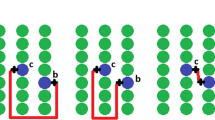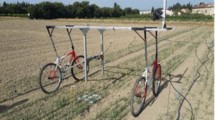Abstract
The reliability of analytical testing is strongly affected by sampling uncertainty. Sampling is always a source of error and the aim of “good” sampling practice is to minimize this error. Generally the distribution of genetically modified (GM) material within lots is assumed to be random in order to use binomial distribution to make inferences. This assumption was never verified in practice and no experimental data investigating the distribution of genetically modified organisms (GMOs) exist. The objectives of the KeLDA project were: (1) to assess the distribution of GM material in soybean lots (2) to estimate the amount of variability of distribution patterns among lots. The GM content of 15 soybean lots imported into the EU was estimated (using real-time PCR methodology) analyzing 100 increment samples systematically sampled from each lot at predetermined time intervals during the whole period of off-loading. The distribution of GM material was inferred by the one-dimensional (temporal) distribution of contaminated increments. All the lots display significant spatial structuring, indicating that randomness cannot be assumed a priori. The evidence that the distribution of GM material is heterogeneous highlights the need to develop sampling protocols based on statistical models free of distribution requirements.




Similar content being viewed by others
References
Cochran GW (1977) Sampling techniques, 3rd edn. Wiley, NY, USA
Binns MR, Nyrop JP, van der Werf W (2000) Sampling and monitoring crop protection. The theoretical basis for developing practical decision guides. CABI Publishing, Oxon, UK
Remund K, Dixon D, Wright D, Holden L (2001) Statistical considerations in seed purity testing for transgenic traits. Seed Sci Res 11:101–120
Paoletti C, Donatelli M, Kay S, Van den Eede G (2003) Simulating kernel lot sampling: the effect of heterogeneity on the detection of GMO contaminations. Seed Sci Tech 31:629–638
Lischer P (2001) Sampling procedures to determine the proportion of genetically modified organisms in raw materials Part I: Correct sampling, good sampling practice. Mitt Lebensm Hyg 92:290–304
Recommendation (2004/787/EC) (2004) On technical guidance for sampling and detection of genetically modified organisms and material produced from genetically modified organisms as or in products in the context of Regulation (EC) No. 1830/2003
prCEN/TS 21568 (2005) Foodstuffs—methods of analysis for the detection of genetically modified organisms and derived products—sampling strategies. CEN, Bruxelles, Belgium
Kay S (2002) Comparison of sampling approaches for grain lots. European Commission Report, Code EUR20134EN, Joint Research Centre Publication Office
Hübner P, Waiblinger H-U, Pietsch K, Brodmann P (2001) Validation of PCR methods for the quantification of genetically modified plants in food. J AOAC Int 84:1855–1864
Coster RM (1993) Seed lot size limitation as reflected in heterogeneity testing: A review. Seed Sci Tech 21:513–520
Gilbert J (1999) Sampling of raw materials and processed foods for the presence of GMOs. Food Contr 10:363–365
Kay S, Paoletti C (2002) Sampling strategies for GMO detection and/or quantification. European Commission Report, Code EUR20239EN, Joint Research Centre Publication Office
Paoletti C (2004) Sampling for GMO analysis: The European perspective. In: Ahmed FE (ed) Testing of genetically modified organisms in food. The Haworth Press, Inc., NY, USA, pp 77–100
KeSTE (2003) Kernel Sampling Technique Evaluation http://www.sipeaa.it/ASP/ASP2/KeSTE.asp
Paoletti C et al. (in preparation): KeLDA project: a comparative study of protein and DNA based methods for GMO testing
ISO-542 (1990) Oilseeds–sampling. International Organization of Standardization, Geneva, Switzerland
ISTA (1999) International Rules for Seed Testing. International Seed Testing Association, Zürich, Switzerland
European Commission (2005) European Commission, DG Health and Consumer Protection http://europa.eu.int/ comm/food/food/biotechnology/authorisation/index_en.htm
ISO-6644 (2002) Flowing cereals and milled cereal products. Automatic sampling by mechanical means. International Organization of Standardization, Geneva, Switzerland
ISO/FDIS-21570 (2005) Foodstuffs—methods of analysis for the detection of genetically modified organisms and derived products—quantitative nucleic acid based methods. Annex C.2. International Organization of Standardization, Geneva, Switzerland
Holst-Jensen A, Rønning SB, Løvseth A, Berdal KG (2003) PCR technology for screening and quantification of genetically modified organisms (GMOs). Anal Bioanal Chem 375:985–993
Thompson M (2000) Towards a unified model of errors in analytical measurement. Analyst 125:2020–2025
Gy P (1998) Sampling for analytical purposes. 1st edn. Wiley, Chichester, UK
D’Agostino RB and Stephens MA (eds) (1986) Goodness-of-fit techniques. Marcel Dekker, Inc., New York, USA
Sokal RR, Oden NL (1978) Spatial autocorrelation in biology 1. Methodology. Biol J Linnean Soc 10:199–228
Slatkin M, Arter HE (1991) Spatial autocorrelation methods in population genetics. Am Nat 138:499–517
Bertorelle G, Barbujani G (1995) Analysis of DNA diversity by spatial autocorrelation. Genetics 140:811–819
Fortin M-J, Drapeau P, Legendre P (1989) Spatial autocorrelation and sampling design in plant ecology. Vegetatio 83:209–222
Fortin M-J, Dale MRT, ver Hoef J (2002) Spatial analysis in ecology. In: El-Shaarawi AH, Piegorsch WW (eds) Encyclopedia of Environmetrics. Wiley, Chichester, UK, pp 2051–2058
Urban DL (2003) Spatial analysis in ecology: Geostatistical data analysis http://www.env.duke.edu/landscape/classes/ env352/autocorr.pdf
Moran PAP (1950) Notes on continuous stochastic phenomena. Biometrika 37:17–23
Oden NL (1984) Assessing the significance of a spatial correlogram. Geogr Anal 16:1–16
Perneger TV (1998) What's wrong with Bonferroni adjustments? BMJ 316:1236–1238
Efron B (1982) The Jackknife, the Bootstrap and other resampling plans. Society for Industrial and Applied Math, Philadelphia, PA, USA
Bjørnstad ON, Falck W (2001) Nonparametric spatial covariance functions: Estimation and testing. Env Ecol Stat 8:53–70
Efron B and Tibshirani RJ (1993) An introduction to bootstrap. Chapman and Hall, London, UK
CRL—Community Reference Laboratory (2005) Analytical Methods Validation Reports. http://gmo-crl.jrc.it/
European Commission (2004) Agriculture in the European Union—Statistical and economic information 2004 http:// europa.eu.int/comm/agriculture/agrista/2004/table_en/index.htm
Minkkinen P (2004) Practical applications of sampling theory. Chemom Intell Lab Syst 74:85–94
Kobilinsky A and Bertheau Y (2004) Minimum cost acceptance sampling plans for grain control, with application to GMO detection. Chemom Intell Lab Syst 75:189–200
Acknowledgments
The authors wish to thank all those who have contributed to the KeLDA project, which was financed by the participating institutions. We are particularly grateful to Professor Kim Esbensen for the many useful discussions and for reviewing a previous version of the manuscript. Thanks to Szilard Szilagyi and Greta Van Neyen for their help preparing the samples.
Author information
Authors and Affiliations
Corresponding author
Rights and permissions
About this article
Cite this article
Paoletti, C., Heissenberger, A., Mazzara, M. et al. Kernel lot distribution assessment (KeLDA): a study on the distribution of GMO in large soybean shipments. Eur Food Res Technol 224, 129–139 (2006). https://doi.org/10.1007/s00217-006-0299-8
Received:
Revised:
Accepted:
Published:
Issue Date:
DOI: https://doi.org/10.1007/s00217-006-0299-8




